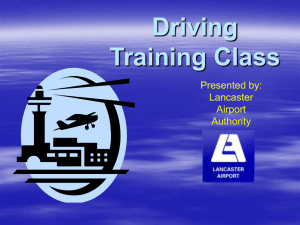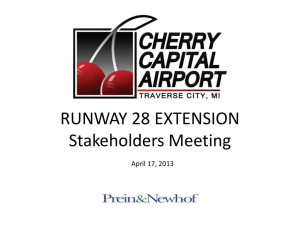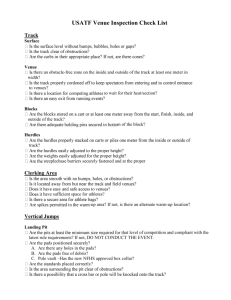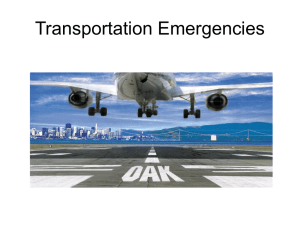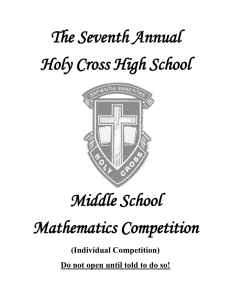Meaning of Each Sign or Marking
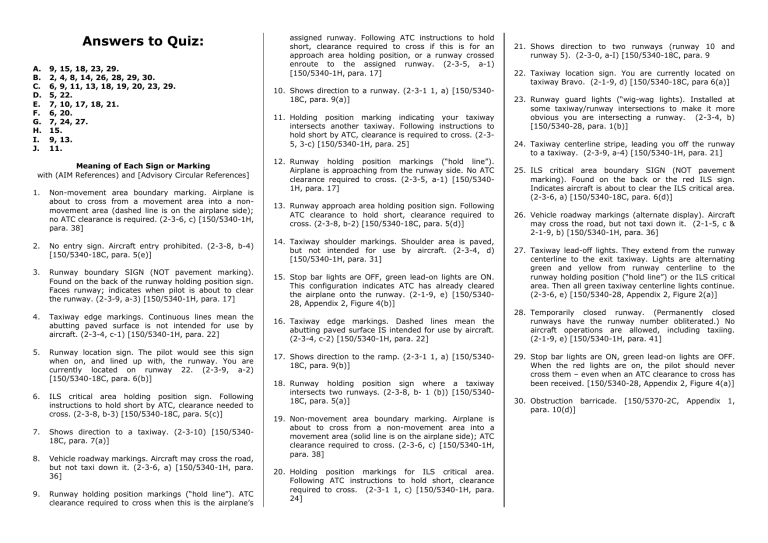
Answers to Quiz:
A.
9, 15, 18, 23, 29.
B.
2, 4, 8, 14, 26, 28, 29, 30.
C.
6, 9, 11, 13, 18, 19, 20, 23, 29.
D.
5, 22.
E.
7, 10, 17, 18, 21.
F.
6, 20.
G.
7, 24, 27.
H.
15.
I.
9, 13.
J.
11.
Meaning of Each Sign or Marking with (AIM References) and [Advisory Circular References]
1.
Non-movement area boundary marking. Airplane is about to cross from a movement area into a nonmovement area (dashed line is on the airplane side); no ATC clearance is required. (2-3-6, c) [150/5340-1H, para. 38]
2.
No entry sign. Aircraft entry prohibited. (2-3-8, b-4)
[150/5340-18C, para. 5(e)]
3.
Runway boundary SIGN (NOT pavement marking).
Found on the back of the runway holding position sign.
Faces runway; indicates when pilot is about to clear the runway. (2-3-9, a-3) [150/5340-1H, para. 17]
4.
Taxiway edge markings. Continuous lines mean the abutting paved surface is not intended for use by aircraft. (2-3-4, c-1) [150/5340-1H, para. 22]
5.
Runway location sign. The pilot would see this sign when on, and lined up with, the runway. You are currently located on runway 22. (2-3-9, a-2)
[150/5340-18C, para. 6(b)]
6.
ILS critical area holding position sign. Following instructions to hold short by ATC, clearance needed to cross. (2-3-8, b-3) [150/5340-18C, para. 5(c)]
7.
Shows direction to a taxiway. (2-3-10) [150/5340-
18C, para. 7(a)]
8.
Vehicle roadway markings. Aircraft may cross the road, but not taxi down it. (2-3-6, a) [150/5340-1H, para.
36]
9.
Runway holding position markings (“hold line”). ATC clearance required to cross when this is the airplane’s assigned runway. Following ATC instructions to hold short, clearance required to cross if this is for an approach area holding position, or a runway crossed enroute to the assigned runway. (2-3-5, a-1)
[150/5340-1H, para. 17]
10.
Shows direction to a runway. (2-3-1 1, a) [150/5340-
18C, para. 9(a)]
11.
Holding position marking indicating your taxiway intersects another taxiway. Following instructions to hold short by ATC, clearance is required to cross. (2-3-
5, 3-c) [150/5340-1H, para. 25]
12.
Runway holding position markings (“hold line”).
Airplane is approaching from the runway side. No ATC clearance required to cross. (2-3-5, a-1) [150/5340-
1H, para. 17]
13.
Runway approach area holding position sign. Following
ATC clearance to hold short, clearance required to cross. (2-3-8, b-2) [150/5340-18C, para. 5(d)]
14.
Taxiway shoulder markings. Shoulder area is paved, but not intended for use by aircraft. (2-3-4, d)
[150/5340-1H, para. 31]
15.
Stop bar lights are OFF, green lead-on lights are ON.
This configuration indicates ATC has already cleared the airplane onto the runway. (2-1-9, e) [150/5340-
28, Appendix 2, Figure 4(b)]
16.
Taxiway edge markings. Dashed lines mean the abutting paved surface IS intended for use by aircraft.
(2-3-4, c-2) [150/5340-1H, para. 22]
17.
Shows direction to the ramp. (2-3-1 1, a) [150/5340-
18C, para. 9(b)]
18.
Runway holding position sign where a taxiway intersects two runways. (2-3-8, b- 1 (b)) [150/5340-
18C, para. 5(a)]
19.
Non-movement area boundary marking. Airplane is about to cross from a non-movement area into a movement area (solid line is on the airplane side); ATC clearance required to cross. (2-3-6, c) [150/5340-1H, para. 38]
20.
Holding position markings for ILS critical area.
Following ATC instructions to hold short, clearance required to cross. (2-3-1 1, c) [150/5340-1H, para.
24]
21.
Shows direction to two runways (runway 10 and runway 5). (2-3-0, a-I) [150/5340-18C, para. 9
22.
Taxiway location sign. You are currently located on taxiway Bravo. (2-1-9, d) [150/5340-18C, para 6(a)]
23.
Runway guard lights (“wig-wag lights). Installed at some taxiway/runway intersections to make it more obvious you are intersecting a runway. (2-3-4, b)
[150/5340-28, para. 1(b)]
24.
Taxiway centerline stripe, leading you off the runway to a taxiway. (2-3-9, a-4) [150/5340-1H, para. 21]
25.
ILS critical area boundary SIGN (NOT pavement marking). Found on the back or the red ILS sign.
Indicates aircraft is about to clear the ILS critical area.
(2-3-6, a) [150/5340-18C, para. 6(d)]
26.
Vehicle roadway markings (alternate display). Aircraft may cross the road, but not taxi down it. (2-1-5, c &
2-1-9, b) [150/5340-1H, para. 36]
27.
Taxiway lead-off lights. They extend from the runway centerline to the exit taxiway. Lights are alternating green and yellow from runway centerline to the runway holding position (“hold line”) or the ILS critical area. Then all green taxiway centerline lights continue.
(2-3-6, e) [150/5340-28, Appendix 2, Figure 2(a)]
28.
Temporarily closed runway. (Permanently closed runways have the runway number obliterated.) No aircraft operations are allowed, including taxiing.
(2-1-9, e) [150/5340-1H, para. 41]
29.
Stop bar lights are ON, green lead-on lights are OFF.
When the red lights are on, the pilot should never cross them – even when an ATC clearance to cross has been received. [150/5340-28, Appendix 2, Figure 4(a)]
30.
Obstruction barricade. [150/5370-2C, Appendix 1, para. 10(d)]
